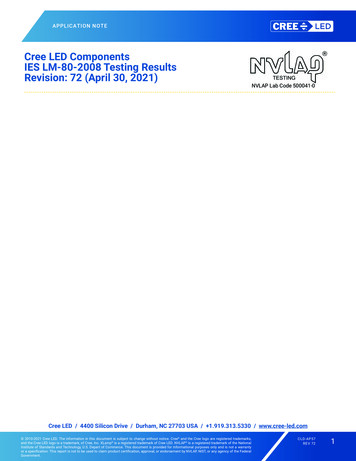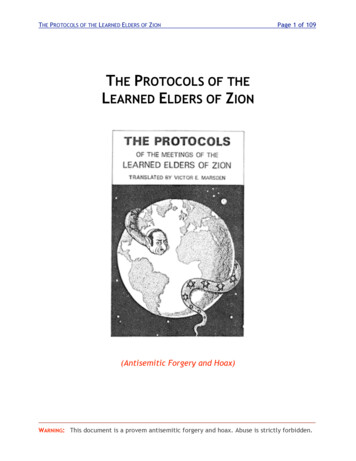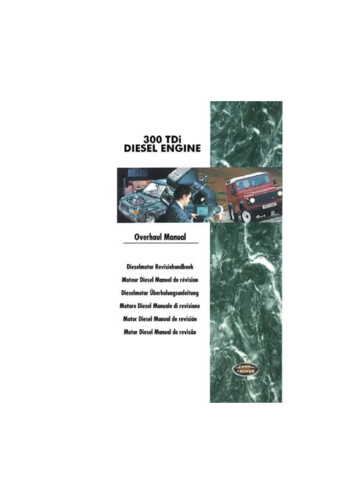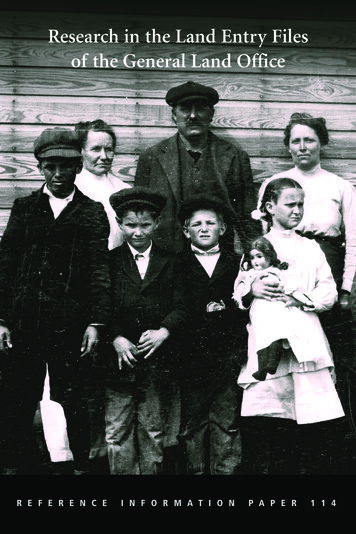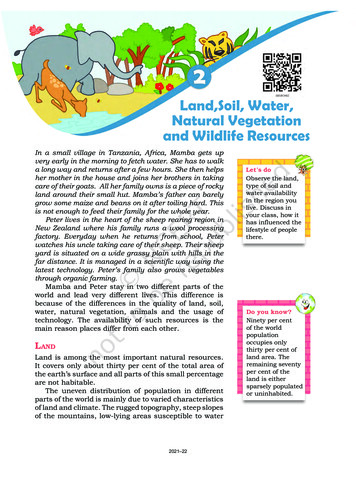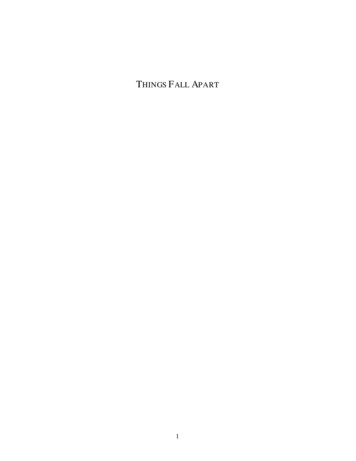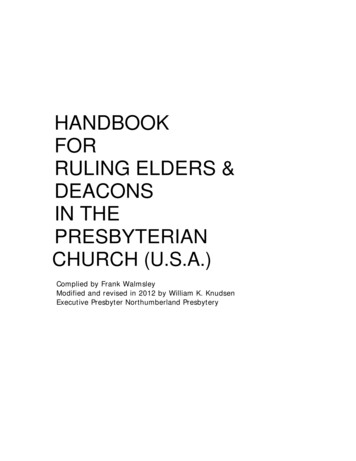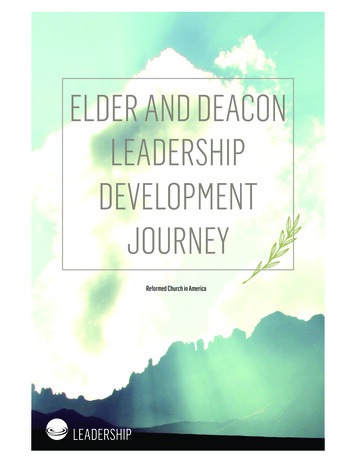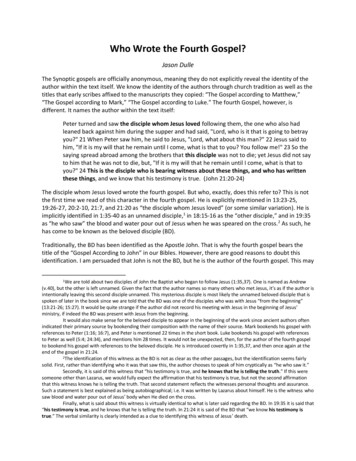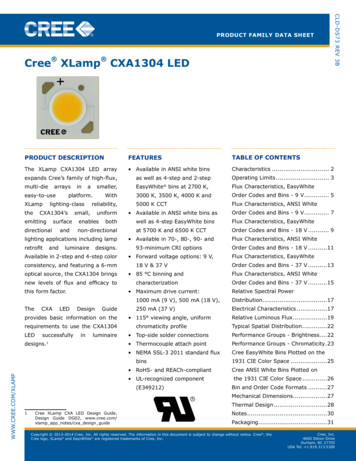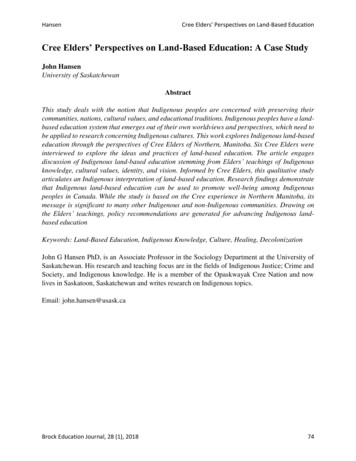
Transcription
HansenCree Elders’ Perspectives on Land-Based EducationCree Elders’ Perspectives on Land-Based Education: A Case StudyJohn HansenUniversity of SaskatchewanAbstractThis study deals with the notion that Indigenous peoples are concerned with preserving theircommunities, nations, cultural values, and educational traditions. Indigenous peoples have a landbased education system that emerges out of their own worldviews and perspectives, which need tobe applied to research concerning Indigenous cultures. This work explores Indigenous land-basededucation through the perspectives of Cree Elders of Northern, Manitoba. Six Cree Elders wereinterviewed to explore the ideas and practices of land-based education. The article engagesdiscussion of Indigenous land-based education stemming from Elders’ teachings of Indigenousknowledge, cultural values, identity, and vision. Informed by Cree Elders, this qualitative studyarticulates an Indigenous interpretation of land-based education. Research findings demonstratethat Indigenous land-based education can be used to promote well-being among Indigenouspeoples in Canada. While the study is based on the Cree experience in Northern Manitoba, itsmessage is significant to many other Indigenous and non-Indigenous communities. Drawing onthe Elders’ teachings, policy recommendations are generated for advancing Indigenous landbased educationKeywords: Land-Based Education, Indigenous Knowledge, Culture, Healing, DecolonizationJohn G Hansen PhD, is an Associate Professor in the Sociology Department at the University ofSaskatchewan. His research and teaching focus are in the fields of Indigenous Justice; Crime andSociety, and Indigenous knowledge. He is a member of the Opaskwayak Cree Nation and nowlives in Saskatoon, Saskatchewan and writes research on Indigenous topics.Email: john.hansen@usask.caBrock Education Journal, 28 (1), 201874
HansenCree Elders’ Perspectives on Land-Based EducationMany contemporary theories, national and international policies do not incorporateIndigenous voices into their understanding of nation, or peoples. Such viewpoints reduceIndigenous peoples to citizens, ethnic groups, racial groups, or interest groups, which donot give accurate representation of who Indigenous peoples are. (Champagne, 2015, p. iv)Champagne (2015) argues that Indigenous voices are often treated as marginal withincontemporary academic theories and institutional policies. Because Indigenous voices aremarginalized, this study sought to promote Indigenous voices in the literature. Since colonizedIndigenous peoples have been deterred from voicing their concerns and practising their ownculture and land-based education traditions, it is understandable that there is a knowledge gap. Itis conceivable, therefore, that a comprehensive discourse on how Omushkegowuk (Swampy Cree)Elders see and understand land-based education is not completely developed in the literature. Thisarticle provides a Cree model of land-based education that outlines the ideas and practices, whichis lacking in the literature. However, this study developed out of the need to examine Eldersteachings and thereby provides an understanding of how land based education occurred. Thisresearch hopes to provide a land based education model, model which have been used by theSwampy Cree—People of the Muskeg—of Northern Manitoba.The Indigenous Elders in this study are members of the Cree Nation who, like many otherIndigenous nations, have been colonized, dispossessed from their lands, and silenced (Adams,1975; Champagne, 2015; Radu, House, & Pashagumskum, 2014). The primary purpose of thisstudy is to engage discussion about Cree Elders’ voices and perspectives on land-based education.In conventional education, Indigenous voices are often marginalized and viewed as beingunimportant or academically irrelevant (Champagne 2015; Hansen & Antsanen, 2016; Truth andReconciliation Commission of Canada [TRCC], 2015). The hypothesis of this discussion is thatIndigenous peoples such as the Cree of Northern Manitoba are part of Canadian society, and willcontinue to be part of the social and cultural fabric of Canada for generations to come. Therefore,it is important to restore and develop land-based education in an Indigenous context.Land-based education has taught people lessons for living for thousands of years—ways of lifethat today can be reclaimed and redeveloped through a decolonization process. The developmentof an Indigenous-based model of education that takes into account the needs, values, teachings,and cultures of Indigenous community members and nations is both a challenging and worthyendeavour. The challenge rests in the fact that Indigenous-based models of education require morefrom the learner than simply studying culture from textbooks. For instance, Indigenous studentsought to have contact with Elders, relatives, and knowledge keepers who can pass downknowledge and culture. An Indigenous-based model of education would help students developsolid community commitments, and to foster knowledge of their culture and identity in ways thatprepare them to be knowledgeable in their own culture and traditions, all the while being fullyprepared to function in Western culture and society.This article provides considerable discussion on Cree Elders’ perspectives of the land, culture,and experience. The article also briefly discusses Western interpretations of Indigenous educationthat creates the need to decolonize and develop land-based education (Adams, 1975; Brown, 2004;Champagne, 2015; Wildcat, McDonald, Irlbacher-Fox, & Coulthard, 2014). In a Western-basededucation system, Elders and cultural knowledge do not have a primary role in educating studentsand consequently students do not gain an understanding of the land and its significance inIndigenous cultures. Decolonization therefore seeks to decentre Western interpretations ofIndigenous education that often do not teach the values, culture, and language of Indigenouspeople.Brock Education Journal, 28 (1), 201875
HansenCree Elders’ Perspectives on Land-Based EducationThis article can be considered a decolonization project. Linda Smith (1999) notes that“decolonization is about centering our concerns and worldviews and then coming to know andunderstand theory from our own perspectives and for our own purposes” (p. 39). Smith revealsthat Indigenous perspectives and worldviews are paramount in a decolonization project, and I hopethat the significance of Cree Elders’ perspectives on land-based education will be reflected in thispaper.Because Elders are guides in many Indigenous communities, the author interviewed six CreeElders as participants in this study to explore the notions of Indigenous land-based education. Thestudy is qualitative in nature and uses ethnographic open-ended interviewing methods, field notes,audio-taped conversations, and observations (Creswell, 1998). The study’s research methodologyis based on Creswell’s (1998) assertion that qualitative research is appropriate when the centralresearch question(s) ask “how” (p. 17), in this case: (a) how Indigenous land-based educationwithin Cree culture is interpreted, and (b) how six Cree elders understand land-based education.The nature of these questions suggests this inquiry is suitable for a qualitative examination.Creswell (1998) notes that a qualitative inquiry entails that “the researcher builds a complex,holistic picture, analyzes words, reports detailed views of informants, and conducts the study in anatural setting” (p. 15).Literature ReviewWhile this study deals primarily with Indigenous Cree teachings in Northern Manitoba, Canada,the ideas relating to Indigenous land education apply to many other Indigenous peoples in Westerncountries. The article encompasses and Indigenous perspective corresponding to the negativeimpacts of colonization on Indigenous communities, Cree cultural understandings of land-basededucation, and spiritual teachings that shape a deep respect for the land. The interviews conductedwith Cree Elders as primary sources also are reflected in the literature. For example, Radu, House,and Pashagumskum’s (2014) influential article “Land, Life, and Knowledge in Chisasibi:Intergenerational Healing in the Bush composes (offers) a Cree account of a matter between theCree and the federal government in which the former were removed from their traditional territory.However, the land continues to be a non-toxic space where traditions and healing still manifest.As Radu et al. (2014) report:In 1980, the Fort George iiyiyiwich were unceremoniously moved across the James Bay tothe present-day community of Chisasibi—a place not of their choosing. The impacts of acumulative range of stressors, from residential school abuses, mercury poisoning, and landloss from hydroelectric development, as well as overt paternalism from both governmentsand settlers working within Cree institutions, have disrupted family structures andundermined individual and community wellbeing. Nevertheless, the land, as much as it hasendured, still offers a place and space where relationships of respect and love can be rebuiltand strengthened. (p. 86)The above passage illustrates how the Cree use the land in ways for subsistence: hunting, fishing,living, and healing. Thus, Indigenous communities tend to perceive and understand the land inways that are spiritual and healing in nature. Many Indigenous Elders teach us that the Creatorprovided the people with particular land to live on and sustain. Indigenous peoples demonstratedappreciation to the Creator through ceremonies, and by showing respect to plants, animals, and theland that enables them to live. Still, they did not consider themselves owners of the land; they usedBrock Education Journal, 28 (1), 201876
HansenCree Elders’ Perspectives on Land-Based Educationthe land in ways that ensured it would be sustained for future generations (Castellano, 2000;Champagne, 2015; Ermine, 1995; Hansen, 2009; Wotherspoon & Hansen, 2013).Indigenous peoples also have a shared colonial experience of being dispossessed from the land(Adams, 2000; Blaut, 1993; Champagne, 2015; Charlton & Hansen, 2017; Hansen & Hetzel, 2018;Hansen, 2012; Hansen, 2015a; Hansen, 2015b; TRCC, 2015; Wildcat et al., 2014). Wildcat et al.(2014) suggest that “if colonization is fundamentally about dispossessing Indigenous peoples fromland, decolonization must involve forms of education that reconnect Indigenous peoples to landand the social relations, knowledges and languages that arise from the land” (p. 1). It is welldocumented that Indigenous peoples in Canada experienced the colonization of their lands, forcedassimilation, residential schooling, and the suppression of their languages, spiritual practices,identity, and culture (Adams, 2000; Antsanen & Hansen, 2012; Blaut, 1993; Champagne, 2015;Charlton & Hansen, 2016; Ermine, 1995; Hansen & Antsanen, 2016; Hansen & Antsanen, 2012;Diangelo & Sensoy, 2012; TRCC, 2015).Although Indigenous peoples have experienced colonization and suppression of their cultures,land-based education ideas and practices still exist within many Indigenous communities. Incontemporary Indigenous communities, there are Elders who continue to teach the succeedinggenerations to have respect for the land, plants, animals, and water. According to the Indigenoussociologist Duane Champagne (2015), the “land was a means for life and livelihood, and the peoplewere guests of the Creator” (p. 4). As Champagne (2015) notes,The land was given to the people by the Creator, who had a sacred task or purpose for thepeople. The people gave thanks to the Creator through ceremonies, and by showing respectto the land, plants, animals and other beings living on the land. Indian people were notowners of the land, and shared the land with other power beings with whom they had toshow respect. (p. 4)These kinds of understandings demonstrate the spiritual nature of Indigenous worldviews andperspectives, which have been an important factor in the development of land-based education(Adams, 1975; Antsanen & Hansen, 2012; Castellano, 2000; Ermine, 1995; Hansen, 2013; TRCC,2015; Wotherspoon & Hansen, 2013).Misinterpretations of Indigenous EducationIn many ways, there have been problems with Western interpretations of what constitutesIndigenous education. As Champagne (2015) observes:About two and half centuries ago, northeastern Indian leaders chided American colonialeducators for wasting their young men in European education. The young men whoattended colonial schools returned with no skills to hunt, could not run, could not take careof themselves in the wilderness, did not fit into tribal communities, and tended to breakdown into depression and drink. (p. 48)Often, the educational approach has persisted in trying to change Indigenous people intoWestern people. According to Wildcat et al. (2014), “Settler-colonialism has functioned, in part,by deploying institutions of western education to undermine Indigenous intellectual developmentthrough cultural assimilation and the violent separation of Indigenous peoples from our sources ofknowledge and strength—the land” (p. 3). In other words, colonial Indigenous education has beengeared towards assimilation into Western culture rather than towards maintaining Indigenousculture and identity. As a result, Indigenous learners have long been perceived as a “problem” inBrock Education Journal, 28 (1), 201877
HansenCree Elders’ Perspectives on Land-Based Educationconventional schools. Adams (1975) maintains that colonial education marginalizes Indigenouslearners and destroys their self-esteem:The school systematically and meticulously conditions natives to a state of inferiorizationand colonization. It does this in a number of ways: most important, however, is that itteaches the languages, literature, and history of the colonizer and thus forces the studentsto deny their language, culture, and essential being. (p. 152)Adams clearly illustrates the tendency of education in Canada to emphasize Westernunderstandings of education. Adams (1975) also states that Indigenous students are socialized toassimilate into the underclass of the society: “Schooling leads to alienation, subordination, andconformity. Instead of providing social mobility and serving as an equalizer for its citizens, itrigidly maintains the class system” (p. 159). Therefore, the dominant groups’ language, history,and culture are emphasized while Indigenous language and culture are marginalized.Decolonizing Indigenous Education: A Land-Based ApproachTimes of course change, and today educational discourse now recognizes that Indigenouseducation should convey Indigenous ways of knowing and being, and so there is much interest indecolonizing Indigenous education. However, any model of decolonizing Indigenous land-basededucation should have a vision and objective for the future well-being of Indigenous communities.In its research with Indigenous Elders, the TRCC (2015) reports that there is much work to bedone in terms of developing the future well-being of Indigenous communities and promoting thereconciliation of relationships:We have work to do. That work we are [already] doing as [Aboriginal] peoples. Ourrelatives who have come from across the water [non-Aboriginal people], you still havework to do on your road. . The land is made up of the dust of our ancestors’ bones. Andso to reconcile with this land and everything that has happened, there is much work to bedone . in order to create balance. (Elder Mary Deleary, as cited in TRCC, 2015, p. 9)Elder Mary Deleary suggests that the land is significant to fostering improved relationships andreconciliation for both Indigenous and non-Indigenous Canadians. However, in order to do so, onemust examine the traditional teachings that demonstrate respect for the land.Many critics recognize the significance of Indigenous teachings in relation to the developmentof Indigenous community well-being and healing (Champagne, 2015; Hansen & Antsanen, 2017;Radu et al., 2014. For instance, Hansen and Antsanen (2017) observe that “Indigenous lives andcommunities can be improved by connecting to traditional teachings, practices and spiritualceremonies” (p. 16). Smith (1999) reminds us that Indigenous education involves a decolonizingmovement that seeks to restore the cultural ideas and practices from a history of colonialoppression, and that “cultural survival, self-determination, healing, restoration and social justiceare engaging Indigenous researchers and Indigenous communities in a diverse array of projects”(p. 142). Indigenous land-based education thus is a fundamental part of decolonization because itpromotes an Indigenous model of education in a culturally appropriate way; it is more than a setof beliefs.Indigenous land-based education has developed into a finely tuned model of Indigenous waysof knowing (Ermine, 1995; Hansen & Antsanen, 2016). Chandler and Lalonde (1998) have foundthat restoring the teachings within Indigenous education has produced some incredible results inIndigenous communities, and that those which “have taken active steps to preserve and rehabilitatetheir own cultures are shown to be those in which youth suicide rates are dramatically lower” (p.Brock Education Journal, 28 (1), 201878
HansenCree Elders’ Perspectives on Land-Based Education191). Brendtro, Brokenleg, and Van Bockern (1998) share a similar perspective and claim that atrisk youth can benefit from being exposed to holistic, traditional Indigenous teachings. Brendtroet al. (1998) further note thatThe number four has sacred meaning to Native people who see the person as standing in acircle surrounded by the four directions. We believe the philosophy embodied in thiscircle of courage is not only a cultural belonging to Native peoples, but a cultural birthrightfor all the world’s children. (p. 45)This passage suggests that Indigenous teachings are relevant to the world and that these teachingscan benefit all humanity.Brown (2004) notes that Western philosophy is not very holistic because it tends to suppressthe emotional realm, and that such a lack of emotional development has had some negative impactson Indigenous peoples:when the European male (Zeno, Plato, Socrates, Aristotle, Descartes, etc.) separated theirmind from their heart . this emotional detachment from their lands allowed them to leavetheir homeland and export their philosophy of oppression throughout the globe. WhenEuropeans became detached from their affective awareness, it allowed them to avoid theemotional feedback from their exploitation of the world’s peoples and environments. Theoppression of the European heart by the European mind was the beginning of theoppression of Indigenous peoples, women, and the earth itself. (p. 28)For Brown, such lack of emotional development has been an important factor in the ensuingexploitation of the land. Similarly, Hart (2002) claims that Eurocentric colonizers espoused twobasic views to justify the exploitation of Indigenous lands:First, they hold a self-righteous stance that their views and actions are the proper and bestones to be held by all peoples of the world. In turn, Aboriginal people’s worldviews aretrivialized, our histories are rewritten from the eyes of the colonizers, and our values aredemeaned and manipulated. The second reason lies with the colonizers’ need to legitimizetheir dominion over Aboriginal peoples’ land. If the Aboriginal peoples’ cultures keepthem tied to the land, then this connection needs to be severed so that the colonizers’ claimover the land and its resources can be confirmed. (p. 25)This passage by Hart, demonstrates the notions of so-called European superiority and Indigenousinferiority that have dominated society for so long. Such views of Indigenous peoples’ inferioritywere a major stimulus towards suppressing Indigenous culture, values, and philosophical thought.Protection of the LandAlthough Indigenous peoples such as the Cree have been colonized, they nonetheless havemaintained their cultural teachings that advocate protection of the land, which is reflected in the“Idle No More” movement. Wotherspoon and Hansen (2013) observe that Idle No More is basedon ancient Indigenous cultural teachings that promote respect for the land and embrace “a visionto protect the land and water that leads to sustaining rather than exploiting the environment” (p.27). Wotherspoon and Hansen (2013) add thatAlthough the Idle No More movement seems to have disappeared from the media, it is infact very much alive and vital in and beyond Indigenous communities. Idle No More hasnot disappeared but has demonstrated its deep roots as part of an established system ofcultural teachings and values that advocate respect for the environment that has beencontinuously reproduced to the present time. Idle No more speaks of modern IndigenousBrock Education Journal, 28 (1), 201879
HansenCree Elders’ Perspectives on Land-Based Educationinterpretations of development that are rooted in the ideology of future wellbeing ofsucceeding generations. (p. 33)Indigenous peoples, communities, and nations are concerned with protecting and preserving theenvironment and their cultural values and understandings. Indigenous peoples are also concernedwith reproducing cultural teachings. As Hansen and Antsanen (2016) note, the Elders “still teachus that the land should not be sold or destroyed” (p. 3). Thus, Indigenous land-based education hasfunctioned to socialize community members into Indigenous society and to respect the land.In spite of the above, Western school systems have failed to develop Indigenous students’potential because of generations of colonial approaches to education. Simply put, many Indigenousstudents are not taught about collective Indigenous values and teachings. In conventionaleducation, Elders often play a marginal role in the teaching of Indigenous students. Consequently,many Indigenous students do not develop their educational potential and do not identify with eitherIndigenous culture or mainstream culture. The Elders suggest that land-based education has thepotential to develop students in ways that promote their individual and community well-being.Research Methods Including the Voices and Knowledge of the EldersIndigenous voices are unheard and often considered to be unimportant and/or academicallyirrelevant within scholarly research (Champagne, 2015; Smith, 1999; Wotherspoon & Hansen,2013). This study argues that Elders have been the customary guides and teachers in Indigenoussocieties for thousands of years, and are still regarded highly in many Indigenous communities atthe present time.As an insider of the group examined in this study and a member of the Opaskwayak CreeNation, I grew up in Northern Manitoba, Swampy Cree territory, and I have observed thetraditional value of respect that the Cree have for the old people. It is the Elders who carry thetraditional knowledge, and it is this source that I wanted to focus on in this research. The Eldersare appreciated for their experience and knowledge of the community—its history, morals,customs, and ceremonies. The Elders play significant teaching roles in many Indigenouscommunities, whether they are widely known or not. I turned to my Elders for knowledge andguidance as is the custom of the Cree. I knew the Elders before I conducted this study, and Irecognize them as my Elders because I have observed their personal character, wisdom, andknowledge of Cree culture. This form of Indigenous research methodology is similarly reflectedin the works of Indigenous scholarship (Brown, 2004; Hansen, 2013; Hansen, Booker, & Charlton,2014; Hart, 2002).ParticipantsThe Elders were recruited from the Opaskwayak Cree Nation territory by the researcher, whoapproached them and explained the nature of the study. Since the Elders knew and trusted me, theywere happy to participate. Opaskwayak Cree Nation is a Swampy Cree (Omushkegowuk) FirstNation community located in Northern Manitoba (about 600 kilometers northwest of Winnipeg),situated at the junction of the Saskatchewan and Pasquia rivers. Opaskwayak Cree Nation has atotal population of 5,368 (Statistics Canada, 2016). The Cree word Opaskwayak means “narrowsbetween woods.”To demonstrate respect for the Elders and honour Indigenous ethics, culturally sensitiveprotocols were followed. This included offering cloth, tobacco, and sweet-grass to demonstrateBrock Education Journal, 28 (1), 201880
HansenCree Elders’ Perspectives on Land-Based Educationrespect and acknowledge the Elders’ contributions to the study. The researcher used the tools ofethnography: open-ended interviewing methods, field notes, and audio-taped conversations.During my interviews with the Elders, I observed their descriptions of land-based education. TheElders taught me much about the traditional teachings and how they perceive and understand theland. I had the privilege of having in-depth conversations with the Elders on topics aboutenvironmental concerns, spirituality, and how personal development was promoted through aspiritual connection to the land. For example, Elder Stella describes her personal development inthe following way:My personal development was given to me in a very deep sense as I was growing upbecause it was connected with my spirituality. And it was the stories that were told thatdeveloped us into who we are because when you think of these stories that were told thereis so much about me that I know is spiritual.The more Cree teachings are examined, the more they are seen as spiritual. Indigenous teachingsare powerful because they become an integral part of the thought processes of the Indigenouspeople in their communities and shape their reality and identity.The particular interpretation of Indigenous Elders depends also upon their particularexperiences. For example, Elder William Lathlin infers that there has to be a spiritual connectionto the land for communities to function:There has to be that connection because if there isn’t, to me, then it’s all hostile; there isno peace. If you go out into the bush by yourself it is so peaceful, and you can hear thebugs on the floor or on the grass and the trees.Specific understandings, and nuances of Cree customs, spirituality and traditional teachings wereobserved in my visits with the Elders, which include significant meanings, values, and perspectivesthat are found the Cree community. As Woods (1996) notes, “ethnography is concerned with whatpeople have, how they behave, how they interact. . It aims to uncover beliefs, values, perspectives,motivations” (p. 4). The interviews were tape recorded with permission and were conducted in thetraditional Omushkegowuk (Swampy Cree) territory of Northern Manitoba. Each Elder wasinterviewed for approximately 90 minutes and all interviews were conducted during the winterseason, which in the Cree culture tends to be a time for sharing stories (Hansen, 2013). All theElders with one exception are named: Jack is the pseudonym for one participant who chose toremain anonymous, and the pseudonym is used to refer to him throughout this paper.Another participant was Sylvia Hansen, who is a member of the Opaskwayak Cree Nation. Shewas born in 1937 and experienced life on Opaskwayak territory; however, like many otherIndigenous children of her time, she was forced to attend residential school. Sylvia is fluent in theCree language. Stella Neff is a member of the Misipawistik Cree Nation or Grand Rapids FirstNation, and is fluent in the Cree language. William G. Lathlin is a member and former chief of theOpaskwayak Cree Nation, and fluent in Cree language. John Martin is a member of theMosakahiken Cree Nation or Moose Lake reserve and is fluent in Cree language. Dennis Thorne,an Elder of mixed Indigenous ancestry (primarily of Cree descent but including also Dakota andOjibwa) was born in 1939 in Wanless, Manitoba, a small Métis community located some 50kilometers north of Opaskwayak Cree Nation.The Elders were interviewed in accordance with Creswell’s (1998) work on qualitativeresearch. As such, the interviews were conducted at a time, place, and setting chosen by the Elders.As Burgess (1984) advises, the open-ended questioning style provides the participants “anopportunity to develop their answers outside a structured format” (p. 102). These open-endedinterviews are also culturally appropriate in the Indigenous community, particularly whenBrock Education Journal, 28 (1), 201881
HansenCree Elders’ Perspectives on Land-Based Educationinterviewing Elders. I transcribed the interviews myself in order to develop a better understandingof the data and to identify common themes to draw conclusions. This process enabled me toidentify common themes in the findings.Analysis of ThemesStake (1995) notes that “there is no particular moment when data analysis begins. Analysis is amatter of giving meaning to first impressions as well as to final compilations” (p. 71). My analysisbegan from the moment I began interviewing the Elders. To ensure that I characterized the Eldersin context, I recorded the interviews and consulted with the Elders to confirm that my interpretationof the transcripts reflected what the Elders meant.During the analysis, I searched for themes in relation to the Elders’ teachings of land-basededucation. I reflected on the data, and the themes that emerged are identified as follows: counselingfrom the Elders, traditional teachings, ceremonies, and a connection to the land. The themesrevealed that obstructions to well-being were disconnection from the land, colonization, andmisuse of medicine. According to most participants, the disconnection from the land weakens thepotential for well-being. A key way Western colonial powers weakened Indigenous nations wasto disconnect Indigenous peoples from the land (Adams, 1975; Antsanen & Hansen, 2012; Hart,2002
were guests of the Creator” (p. 4). As Champagne (2015) notes, The land was given to the people by the Creator, who had a sacred task or purpose for the people. The people gave thanks to the Creator through ceremonies, and by showing respect to the land, plants, animals an
